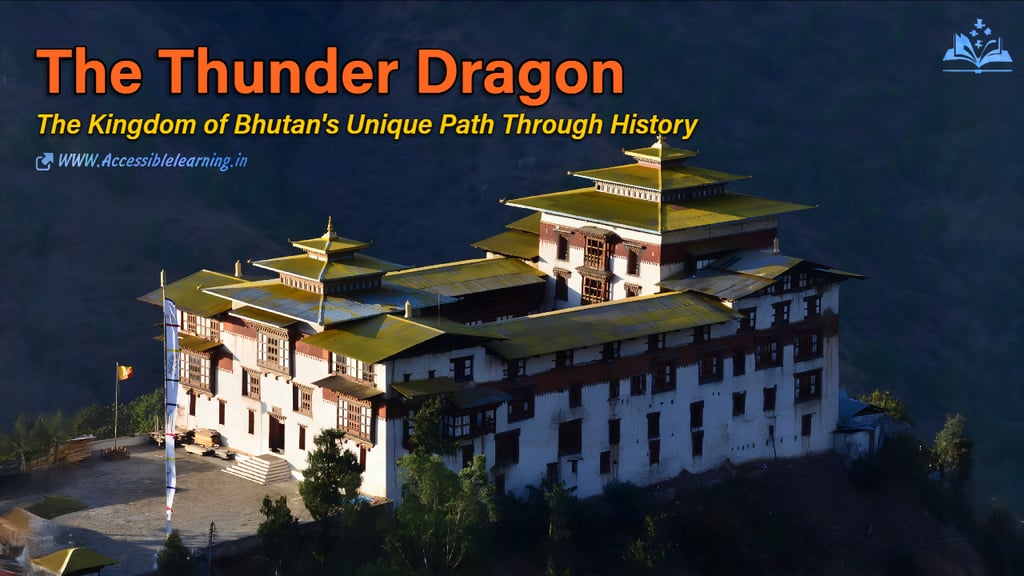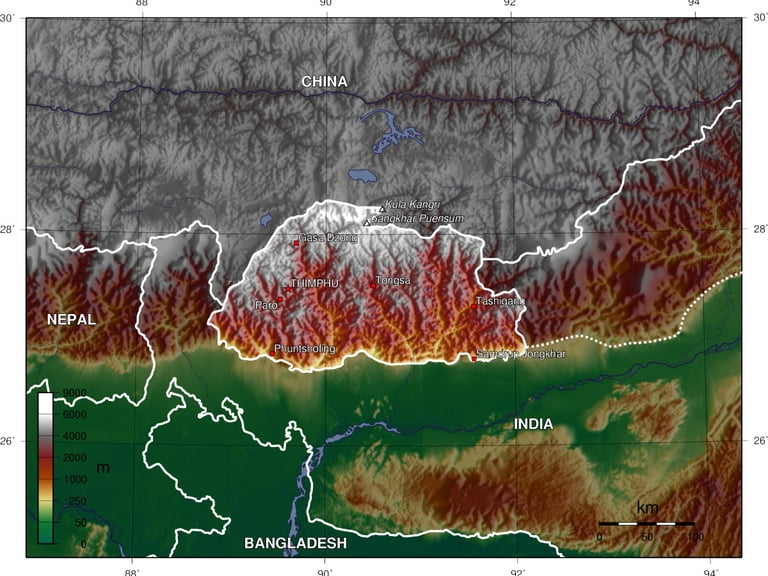
The Kingdom of Bhutan: A Hidden Himalayan Gem
Discover the rich history, cultural treasures, and sustainable approach to development that have made Bhutan one of the world's most distinctive nations. From its unification in the 17th century to its groundbreaking Gross National Happiness philosophy, explore how this Himalayan kingdom has maintained its independence and identity while charting its own path to modernity.
EDUCATION/KNOWLEDGEHISTORYEMPIRES/HISTORY
Kim Shin
4/19/202510 min read


Nestled in the Eastern Himalayas between China and India lies Bhutan, a small nation with a rich cultural heritage and a unique approach to national development. While Bhutan has never been an empire in the traditional sense, its history as an independent kingdom with a distinct national identity makes it a fascinating subject. This article explores the history, culture, and modern evolution of the Kingdom of Bhutan, offering insights into this often overlooked Himalayan nation.
Geographic Context
Covering approximately 38,394 square kilometers, Bhutan's landscape rises dramatically from the subtropical plains in the south to alpine regions in the north, with elevations ranging from 200 meters to more than 7,000 meters above sea level. The country's geography has played a crucial role in its history, with mountain passes serving as natural defenses that helped maintain independence while influencing distinct regional cultures within the nation.
Major geographical regions include the southern foothills, the Inner Himalayas characterized by fertile valleys like Paro, Thimphu, and Punakha, and the Great Himalayas in the north featuring permanently snow-covered peaks. The country's varied ecosystems host exceptional biodiversity, including endangered species like the Bengal tiger, snow leopard, and black-necked crane.
Pre-Unification History
Archaeological evidence suggests human settlement in Bhutan dates back to 2000 BCE. The early history was characterized by small, independent fiefdoms with varying allegiances and a mix of indigenous Bon religious practices and Buddhism. By the 7th century CE, the Tibetan king Songtsen Gampo constructed the first Buddhist temples in Bhutan, including Kyichu Lhakhang in Paro and Jambay Lhakhang in Bumthang.
The 8th century saw the arrival of Guru Padmasambhava (known locally as Guru Rinpoche), who introduced the Nyingma school of Buddhism. His journey across Bhutan is marked by numerous sacred sites where he is said to have subdued local deities and converted them to protectors of Buddhism. This religious foundation became intrinsic to Bhutanese identity.
Historical Foundations
Bhutan's recorded history begins in the 7th century with the construction of Buddhist temples. However, the nation as we recognize it today began taking shape in the 17th century. In 1616, Ngawang Namgyal, a Tibetan Buddhist lama, arrived in Bhutan and unified the various fiefdoms under a dual system of governance with both religious and administrative leaders.
This period marked the birth of Bhutan as a distinct political entity. Namgyal, who received the title Zhabdrung (meaning "at whose feet one submits"), established a comprehensive system of laws and built dzongs—fortress monasteries that served as religious, military, administrative, and social centers. Many of these impressive structures still stand today, serving as living monuments to Bhutan's enduring cultural traditions.
The Zhabdrung's system, known as Chos-sid-nyi (dual system of religion and politics), created separate authorities: the Je Khenpo (Chief Abbot) heading religious affairs and the Druk Desi (Temporal Ruler) managing administrative matters. This separation of powers was innovative for its time and remained the foundation of Bhutanese governance until the 20th century.
Conflicts and External Relations
Throughout the 18th and 19th centuries, Bhutan experienced periods of conflict both internally and with external powers. The country fought several wars with Tibet and dealt with British colonial expansion in the region. The Anglo-Bhutanese War of 1864-1865 (also known as the Duar War) resulted in Bhutan ceding control of the Bengal Duars (lowland areas) to British India in exchange for an annual subsidy.
The Treaty of Punakha in 1910 established British guidance of Bhutan's foreign affairs while maintaining internal independence. This arrangement provided crucial protection during a time when imperial powers were establishing control throughout Asia. It also set the foundation for later relations with independent India after 1947.
The Wangchuck Dynasty
After a period of civil war and political instability following Zhabdrung Namgyal's death, Bhutan entered a new era in 1907 when Ugyen Wangchuck was elected as the first hereditary monarch, establishing the Wangchuck dynasty that continues to reign today.
Ugyen Wangchuck (r. 1907-1926) consolidated power and built relationships with British India. His son, Jigme Wangchuck (r. 1926-1952), strengthened central authority and initiated the first steps toward modernization while maintaining Bhutan's traditional values.
Under the Wangchuck monarchs, Bhutan maintained its independence despite the colonization occurring throughout the region. The country deliberately limited outside influences, maintaining its unique cultural identity while slowly and carefully introducing modern developments.


Isolation and Preservation
What makes Bhutan remarkable in world history is not imperial expansion but rather its deliberate isolation. Until the 1970s, Bhutan remained largely closed to outsiders, with no national currency, postal system, or formal diplomatic relations with other countries. This isolation was not born of hostility but rather a conscious choice to preserve Bhutanese culture and independence.
This approach allowed Bhutan to maintain traditions, architectural styles, religious practices, and social structures that disappeared in neighboring regions. The traditional dress (the gho for men and kira for women), architectural standards requiring buildings to follow traditional designs, and the preservation of natural environments all stem from this deliberate policy of cultural continuity.
The period of isolation had practical consequences as well. Without roads connecting different regions until the 1960s, distinct local cultures developed in valleys separated by high mountain passes. These regional variations in dialect, dress, and customs contribute to Bhutan's cultural richness while remaining united under shared Buddhist values and national identity.
Modern Transformation
Bhutan's journey into modernity began in earnest under the leadership of the third king, Jigme Dorji Wangchuck (r. 1952-1972), often called the "Father of Modern Bhutan." He abolished serfdom, established a national assembly, created a royal advisory council, reorganized the judicial system, and initiated the first Five-Year Development Plan in 1961. Under his reign, Bhutan joined the United Nations in 1971, marking its emergence on the international stage.
His son, Jigme Singye Wangchuck (r. 1972-2006), continued this transformation while maintaining Bhutan's unique character. He focused on decentralization, rural development, and building infrastructure while strictly controlling tourism and outside influences. His reign saw significant improvements in education, healthcare, and economic development.
The fourth king introduced the revolutionary concept of Gross National Happiness (GNH) as an alternative to Gross Domestic Product, proposing that national development should be measured not just in economic terms but also through cultural preservation, environmental sustainability, good governance, and the well-being of citizens.
In 2008, Bhutan transitioned from an absolute monarchy to a constitutional monarchy and parliamentary democracy, with the first democratic elections held under the guidance of the fifth king, Jigme Khesar Namgyel Wangchuck (r. 2006-present), who continues to play a unifying role in Bhutanese society while promoting democracy and modernization.
Cultural Treasures
Bhutan's cultural landscape is dominated by Vajrayana Buddhism, which influences everything from daily rituals to national policies. Monasteries serve as centers of learning and culture. Colorful religious festivals known as tshechus feature elaborate masked dances that tell stories of Buddhist teachings and local mythology.
The country's traditional arts, known as zorig chusum (thirteen traditional crafts), include painting, woodcarving, and textile weaving. These practices continue to thrive, with government support ensuring the transmission of these skills to new generations.
Thangka painting, a complex art form depicting Buddhist deities and mandalas, exemplifies Bhutan's artistic tradition. These religious paintings follow strict iconographic rules while allowing for personal expression within the tradition. Similarly, mask-making for religious dances combines spiritual significance with artistic excellence.
Bhutanese architecture is distinctive, with dzongs representing the pinnacle of this tradition. These massive structures combine defensive capabilities with administrative functions and religious spaces. Built without nails or written plans, dzongs feature massive white walls with intricate woodwork painted in vibrant colors. The Punakha Dzong, Tashichho Dzong in Thimphu, and Paro Dzong are magnificent examples of this architectural tradition.
Language and Literature
Dzongkha, the official language, belongs to the Tibetic language family but has developed distinct characteristics. Regional languages like Sharchopkha and Bumthangkha reflect Bhutan's linguistic diversity. Traditional literature includes religious texts, historical chronicles, and folk stories transmitted orally for generations before being recorded.
The epic of Gesar of Ling, a Central Asian hero tale also popular in Tibet and Mongolia, has distinct Bhutanese versions. Buddhist biographical literature, particularly accounts of tertöns (treasure revealers) who discovered religious texts and artifacts hidden by Guru Rinpoche, forms another important literary tradition.
Religious Landscape
While Vajrayana Buddhism is the state religion, Bhutan's religious landscape is nuanced. Different Buddhist schools coexist, with the Drukpa Kagyu school having official status but Nyingma traditions remaining strong, particularly in eastern regions. Hindu practices are common among the Lhotshampa population in southern Bhutan, and indigenous Bon beliefs continue to influence local religious practices.
Sacred sites dot the landscape, from famous monasteries like Taktsang (Tiger's Nest) Monastery perched dramatically on a cliff face to remote meditation caves used by revered figures. Religious practice remains vibrant, with daily offerings made at household altars and prayer flags carrying mantras on the wind from mountain passes and bridges.


Environmental Leadership
Despite its small size, Bhutan has emerged as a global environmental leader. The constitution mandates that a minimum of 60% of the country remain forested for all time. Currently, forests cover over 70% of the land, making Bhutan not just carbon neutral but carbon negative—it absorbs more carbon than it emits.
Bhutan's protected areas system includes five national parks, four wildlife sanctuaries, and multiple biological corridors connecting these areas. The Jigme Dorji National Park (the largest), Jigme Singye Wangchuck National Park, and Royal Manas National Park protect critical habitats ranging from subtropical forests to alpine meadows.
This environmental stewardship reflects both Buddhist values of harmony with nature and pragmatic recognition of the importance of natural resources for the predominantly agricultural population. Bhutan's approach to hydropower development exemplifies this balance, generating revenue through electricity exports to India while maintaining watershed integrity through forest conservation.
Political System and Governance
Bhutan's transition to democracy presents a rare case of monarchical initiative rather than popular demand driving political change. The fourth king voluntarily devolved power, introduced a constitution, and abdicated in favor of his son to facilitate this transition.
The current political system features a bicameral parliament consisting of the National Council (upper house) and National Assembly (lower house). Multi-party elections determine the composition of the National Assembly, with the winning party forming the government. The constitution establishes Buddhism as the spiritual heritage while ensuring religious freedom.
Local governance operates through Dzongkhag (district) and Gewog (block) administrations with elected officials. This decentralized approach aims to involve citizens in decision-making while maintaining national cohesion.
Economic Development
Bhutan's economy has traditionally been based on subsistence agriculture, animal husbandry, and forestry. Modern development has focused on sustainable sectors like hydropower, which now provides over 70% of government revenue through electricity exports to India.
Tourism operates under the principle of "high value, low impact," with visitors required to pay a Sustainable Development Fee (currently $200 per person per day) that covers accommodations, meals, guides, and internal transportation. This approach limits tourist numbers while ensuring tourism benefits contribute to national development.
Other growing sectors include construction, small-scale manufacturing, and information technology. Traditional crafts like textiles and woodworking also contribute to economic activity, particularly in rural areas where they provide supplementary income for farming families.
Social Structure and Ethnic Composition
Bhutanese society is predominantly comprised of three main ethnic groups: the Ngalop (of Tibetan origin) in the west and north, the Sharchop (considered the original inhabitants) in the east, and the Lhotshampa (of Nepali origin) in the south. Additional small indigenous groups with distinct languages and customs add to this diversity.
The social structure historically included aristocratic families, monastic communities, farming villages, and nomadic herders. Modern education and economic development have created new social categories based on profession and education, though traditional family and community ties remain important.
The issue of the Lhotshampa population became controversial in the late 1980s and 1990s when concerns about preserving Bhutanese cultural identity led to policies requiring adherence to northern Bhutanese cultural practices. This resulted in ethnic tensions and the departure of many Lhotshampa to refugee camps in Nepal, an issue that has been partially resolved through third-country resettlement programs.
Challenges and Future Prospects
Today's Bhutan faces the challenge of balancing tradition with modernization. The country has experienced significant economic growth, improved healthcare and education, and increased international engagement while working to preserve its cultural identity.
Youth unemployment, rural-to-urban migration, and the influences of global media present new challenges. The tourism model of "high value, low impact" aims to generate revenue while limiting cultural and environmental disruption, with visitors required to pay a daily fee that includes a sustainable development contribution.
Climate change poses particular threats to Bhutan's mountainous landscape, with glacial lakes expanding due to melting ice, creating risks of catastrophic flooding. The country is implementing adaptation strategies while continuing to advocate for global climate action.
Reconciling economic development with environmental conservation remains an ongoing challenge. Hydropower development, while providing clean energy and revenue, requires careful management to minimize ecological impacts. Similarly, urban growth, particularly in the capital Thimphu, creates pressure for housing and infrastructure that must be balanced with cultural and environmental considerations.
Digital connectivity presents both opportunities and challenges. While providing access to global knowledge and markets, it also introduces values and expectations that sometimes conflict with traditional Bhutanese approaches. The government is working to develop "digital Drukyul" (digital Bhutan) in ways that support rather than undermine national values.


International Relations
Bhutan maintains a carefully managed approach to international relations. India remains its closest partner, with treaties governing trade, development assistance, and defense cooperation. Relations with China involve ongoing border negotiations but no formal diplomatic ties.
Beyond these immediate neighbors, Bhutan engages selectively with international organizations and bilateral partners. It maintains diplomatic relations with over 50 countries but has embassies in only a handful, reflecting both practical resource constraints and philosophical preferences for quality over quantity in relationships.
Bhutan's diplomatic approach emphasizes environmental leadership, cultural preservation, and alternative development models. Its advocacy for Gross National Happiness has influenced global discussions on sustainability and well-being, with the United Nations adopting elements of this approach in measuring development progress.
While never an empire in terms of territorial conquest, Bhutan's achievement lies in maintaining independence and cultural continuity through turbulent historical periods. From its unification under Zhabdrung Namgyal to its current status as a constitutional monarchy, Bhutan has charted its own course, prioritizing happiness over materialism and sustainability over unchecked growth.
As the world faces environmental crises and questions about the purpose of economic development, Bhutan's approach offers valuable alternative perspectives. The "Thunder Dragon Kingdom," as it is sometimes known, may be small in size, but its contributions to global conversations about development, happiness, and sustainability are increasingly significant.
In an interconnected world where cultural homogenization is common, Bhutan stands as a reminder that alternative paths to modernity exist—ones that honor tradition while embracing positive change, creating a unique national identity that continues to evolve on its own terms.
Subscribe To Our Newsletter
All © Copyright reserved by Accessible-Learning Hub
| Terms & Conditions
Knowledge is power. Learn with Us. 📚


